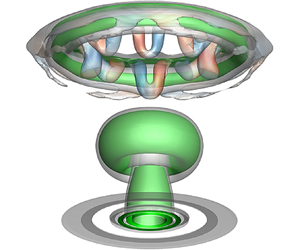Published online by Cambridge University Press: 06 June 2022

The vortex dynamics in a stratified environment is of fundamental importance in various flow systems, however, the mechanism of successive vortex–interface interactions remains not fully understood. This study investigates synthetic jet vortex rings impinging on a water–oil interface by experiment and numerical simulation. Two cases in the laminar and transitional regimes are concerned with the Froude number (Fr) of 0.35 and 0.82, respectively. The vortex rings for the two cases follow a similar evolution with three distinct stages, including vortex free-travel, vortex–interface interaction and vortex stretching. As products of the vortex–interface interaction, the secondary vortex rings are baroclinically generated in both water and oil followed by the formation of hairpin vortices through azimuthal deformation. Distinguished from an isolated vortex–interface interaction, complex interactions occur between the primary vortex ring and hairpin vortices, which can enhance the vortex ring instability in existence of the stratification for the laminar case. However, the vortex ring instability for the transitional case can develop earlier due to nonlinear effects with increasing Reynolds number. The spatio-temporal properties of the interface deformation and interfacial waves are analysed. The maximum penetration height of vortex rings scales with Fr2 as that for the isolated situation. Particularly, the transitional case is found to produce destabilization of the interfacial waves at a further radial location. The mechanism is revealed by connecting the dynamics of the vortex and the interface, which can be attributed to the radial development of perturbances stemming from the vortex ring instability under strong vortex–interface interaction.